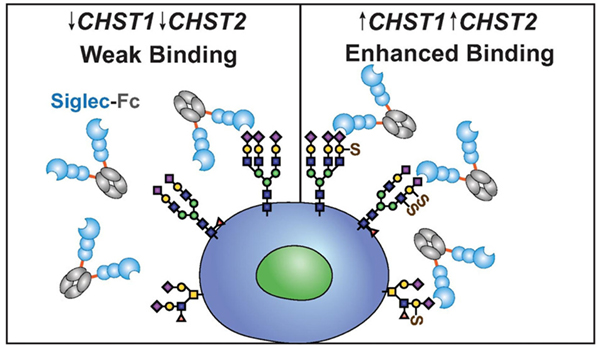
 中央研究院 生物化學研究所
中央研究院 生物化學研究所
The immunomodulatory family of Siglecs recognizes sialic acid-containing glycans as “self”, which is exploited in cancer for immune evasion. The biochemical nature of Siglec ligands remains incompletely understood, with emerging evidence suggesting the importance of carbohydrate sulfation. Here, we investigate how specific sulfate modifications affect Siglec ligands by overexpressing eight carbohydrate sulfotransferases (CHSTs) in five cell lines. Overexpression of three CHSTs─CHST1, CHST2, or CHST4─significantly enhance the binding of numerous Siglecs. Unexpectedly, two other CHSTs (Gal3ST2 and Gal3ST3) diminish Siglec binding, suggesting a new mode to modulate Siglec ligands via sulfation. Results are cell type dependent, indicating that the context in which sulfated glycans are presented is important. Moreover, a pharmacological blockade of N- and O-glycan maturation reveals a cell-type-specific pattern of importance for either class of glycan. Production of a highly homogeneous Siglec-3 (CD33) fragment enabled a mass-spectrometry-based binding assay to determine ≥8-fold and ≥2-fold enhanced affinity for Neu5Acα2-3(6-O-sulfo)Galβ1-4GlcNAc and Neu5Acα2-3Galβ1-4(6-O-sulfo)GlcNAc, respectively, over Neu5Acα2-3Galβ1-4GlcNAc. CD33 shows significant additivity in affinity (≥28-fold) for the disulfated ligand, Neu5Acα2-3(6-O-sulfo)Galβ1-4(6-O-sulfo)GlcNAc. Moreover, joint overexpression of CHST1 with CHST2 in cells greatly enhanced the binding of CD33 and several other Siglecs. Finally, we reveal that CHST1 is upregulated in numerous cancers, correlating with poorer survival rates and sodium chlorate sensitivity for the binding of Siglecs to cancer cell lines. These results provide new insights into carbohydrate sulfation as a general mechanism for tuning Siglec ligands on cells, including in cancer.
